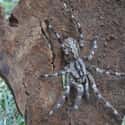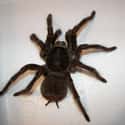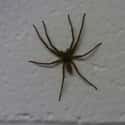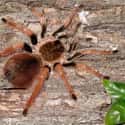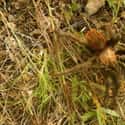-
(#6) Colombian Lesserblack Tarantula
The Xenesthis immanis, more commonly known as the Colombian Lesserblack, is one of the most striking of the giant spiders in nature. This makes this large tarantula, another in the Birdeater family, a popular pet. Its black coloring is contrasted by blond "bad hair day" hairs on its abdomen and purplish markings on the top of the head.
With a leg span that reaches around 8 inches, it's also one of the largest spiders in the world.
Average Size: The largest Colombian Lesserblacks have a leg span of up to 8½ inches or more.
Comparative Size: At 8½ inches, the leg span of a Colombian Lesserblack is almost the same size as a bowling ball.
Region: As the name implies, the Colombian Lesserblack hails from Colombia, but specimens have also been found in Venezuela, Ecuador, and Panama.
Is It Dangerous To Humans? Even though the Lesserblack is a popular pet, not a lot of research has yet been conducted on the potency of its venom. However, like most tarantulas, its bite is probably mostly harmless to humans, beyond the pain caused by the fangs themselves.
-
(#5) Face-Sized Tarantula
If that name doesn't make you uncomfortable, you're probably not an arachnophobe. Its scientific name is Poecilotheria rajaei, but the recently discovered Face-Sized tarantula got its common name because, well, it's as big as your face! This Sri Lankan tarantula has also started making its way into buildings more and more often, as its preferred habitat (old-growth trees) is lost to deforestation. With enough venom to take the lives of small rodents, birds, lizards, and even snakes, the Face-Sized tarantula is also quite fast.
Fortunately for arachnophobes (and unfortunately for the Poecilotheria rajaei), it is fairly rare, even in its native country, and the elimination of its natural habitat has likely rendered this enormous spider rarer still.
Average Size: The Poecilotheria rajaei has a leg span of about 8 inches. However, its body is relatively small compared to its legs, at least as tarantulas go.
Comparative Size: It's right there in the name. The Face-Sized tarantula is as big as an average person's face.
Region: Discovered in 2009, the Poecilotheria rajaei has, thankfully, thus far only been found in Sri Lanka, so unless you're exploring abandoned buildings there, you probably don't have to worry about running into one.
Is It Dangerous To Humans? The bite of a Face-Sized tarantula is deadly to snakes, lizards, birds, and small mammals, but it isn't going to do much to a person. That's probably not a lot of comfort if you wake up in the middle of the night with one proving the truth of its name, though.
-
(#1) Goliath birdeater
- Theraphosa blondi
Considered the largest spider in the world (that we've discovered so far, anyway), the Goliath Birdeater is, as its name would suggest, large enough to eat birds, though it rarely does. An 18th-century engraving by German naturalist Maria Sibylla Merian depicts this massive arachnid devouring a hummingbird and helped to give the Birdeater its name.
This opportunistic hunter will target anything it encounters that's small enough to eat, including small mammals, frogs, large insects, and even lizards and snakes. However, because it hunts on the ground, it doesn't get the chance to snack on birds very often. Most of the Goliath Birdeater's diet actually consists of something that birds themselves are also known to eat: earthworms, which come up out of the ground during the night, the same time that this massive spider is out prowling the jungle floor.
Average Size: The Goliath Birdeater has a leg span of up to 12 inches and a heavy body that can reach almost 5 inches in length. While the Giant Huntsman spider is sometimes considered larger, the Goliath Birdeater is considerably heavier, weighing up to a little over 6 ounces - that's heavier than a baseball!
Comparative Size: These puppy-sized spiders have bodies bigger than a human fist and a leg span that can exceed the dimensions of a dinner plate.
Region: The Goliath Birdeater makes its home in the Amazon jungle and rainforests across South America, including in parts of Suriname, Guyana, Venezuela, and Brazil.
Is It Dangerous To Humans? With a pair of massive fangs that can reach 1½ inches in length, if the Goliath Birdeater bites you, it's going to hurt. However, the bite of a Goliath Birdeater, while venomous, isn't deadly to humans, though it might make you feel flushed and nauseated. The shy Birdeater isn't likely to bite you unless you strike it or its egg sacs, though. You're more likely to encounter the defense mechanism it uses to fend off predators: shedding irritating hairs that can get into the eyes and nose that cause pain and irritation for days.
-
(#12) Hawaiian Cane Spider
The Hawaiian Cane spider achieved viral internet fame thanks to a doctored photo (that was actually of a wolf spider) claiming to show a Giant Hawaiian Cane spider (or, in other variations, an Angolan Witch spider or a Colombian Diablo spider) with a leg span of nearly 6 feet clutched onto the side of a Florida house. The giant arachnid in the picture may have been a bit of digital trickery, but the Hawaiian Cane spider is real enough.
While actual Cane spiders are nowhere near 6 feet, they're still pretty big, as spiders go. With a body about an inch long and a leg span that can reach 5 inches, these spiders don't spin webs but instead hunt for their food. As their name implies, they're fond of cane fields, and they sometimes make their way into homes, but they're quite harmless to humans, and actually good for catching bugs and other pests. They're also good mothers. In fact, the mother Cane spider carries her egg case around in her mouth for up to a month, during which time she doesn't eat in order to guard her young.
Average Size: While 5 inches may not appear like a lot after seeing a doctored photo of a spider 6 feet across, the Hawaiian Cane spider does still get pretty big.
Comparative Size: With a 5-inch leg span, the Cane spider is about the size of a can of tuna.
Region: Cane spiders can be found on every one of the Hawaiian islands where, as their name suggests, they like to hang out in cane fields.
Is It Dangerous To Humans? Nope! Cane spiders rarely bite, and when they do, they seldom inject venom. Even if you are exposed to Cane spider venom, it's unlikely to cause you any problems unless you're allergic. In fact, Cane spiders are quite beneficial to have around because they prey on pest insects.
-
(#8) Colombian Giant Redleg Tarantula
Three words: "cartwheel of death." That's what some people have taken to calling the unique defensive behavior of the Colombian Giant Redleg tarantula. While most tarantulas wave their front legs and bare their fangs when threatened, the Colombian Redleg does something very different. It spins in a circle. This isn't just showing off, though. It adds thrust to the barbs that line this particular tarantula's back legs. These irritating barbs can scrape predators or get hurled into the air to clog mucous membranes, causing pain or temporary blindness.
It's also sometimes called the Eye-Candy tarantula due to its unique markings.
Average Size: With a leg span ranging from 6 to 8 inches, that's a lot of back leg to throw those barbs from!
Comparative Size: Even at the small end, they're still almost twice the size of a softball.
Region: This striking and unique tarantula hails from Colombia.
Is It Dangerous To Humans? Like most tarantulas, the Redleg is venomous, but not enough so to do much harm to humans unless they happen to be allergic. What you've got to be more concerned about is that aforementioned "cartwheel of death." It certainly won't cause your demise, but it can cause a lot of pain and discomfort if those barbs get in your nose or eyes.
-
(#4) Giant Tawny Red Tarantula
Most of the biggest spiders in the world are members of the tarantula family, and the Brazilian Giant Tawny Red is no exception. With a leg span that can exceed 10 inches, this is one of the largest spiders in the world. Relatively common compared to some of the others, they are actually sold in pet stores the world over. The Giant Tawny Red tarantula is also notable for its parenting. While most spiders lay eggs and then abandon them, the Tawny Red will actually stick around to guard its egg sacs and help its young hatch.
Average Size: The largest Giant Tawny Red tarantula measured so far had a leg span of just over 10 inches.
Comparative Size: Giant Tawny Red tarantulas can grow to the size of a small pizza - maybe even a little bigger.
Region: While they are native to places like Brazil, Paraguay, Uruguay, and Argentina, the popularity of the Tawny Red tarantula as a pet means that it is sold in pet stores all around the globe.
Is It Dangerous To Humans? Tawny Red tarantulas are considered docile - this is one of the reasons they make good pets. They have been known to bite if they are handled too frequently, but their venom isn't deadly to a human. Like many tarantulas, Tawny Reds have irritating hairs that they can shed if threatened. These hairs can cause irritation and even blindness if they are inhaled or get into the eyes.
New Random Displays Display All By Ranking
About This Tool
It is impossible to have a spider as big as a slap in our cognition, but there are indeed giant spiders in the spider world. There are about 40,000 different spider species living on the earth. They crawl on the web with their 8 furry legs and ready to pounce and kill prey anytime they want. There is no doubt that spiders are small but they can bring a nightmare. Usually, we see spiders that are only a few centimeters long, and some spiders that can be raised can reach the size of a palm.
The largest spider we know so far is Theraphosa Blondi, officially recognized by the Guinness Book of World Records, its legs can be up to 30 cm long, which is equivalent to the length of a child's forearm. The random tool lists 12 other biggest spiders on the planet.
Our data comes from Ranker, If you want to participate in the ranking of items displayed on this page, please click here.











